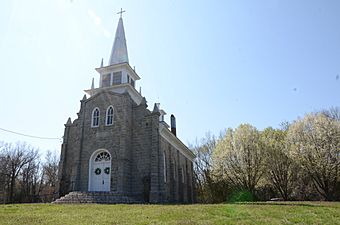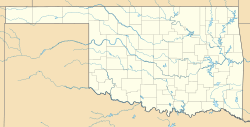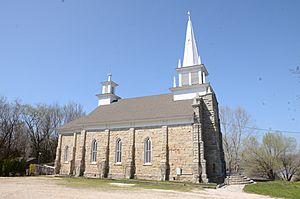Splitlog Church facts for kids
Quick facts for kids |
|
|
Splitlog Church
|
|

Splitlog Church, NE View
|
|
| Nearest city | Grove, Oklahoma |
|---|---|
| Area | 0.5 acres (0.20 ha) |
| Built | 1893 |
| Built by | Splitlog, Mathias |
| NRHP reference No. | 72001061 |
| Added to NRHP | October 26, 1972 |
The Splitlog Church is a very old church building located near Grove, Oklahoma, in a small community called Cayuga. It's also known as the Cayuga Mission Church. This special church is named after Mathias and Eliza Splitlog, who built it and helped start the town of Cayuga. Cayuga was once a busy place with many businesses in the late 1800s. The church was added to the National Register of Historic Places in 1972, which means it's an important historical site. People still use it as a church today.
Contents
What Makes the Church Special?
Outside the Church
The church building is about 50 feet (15 meters) long and 30 feet (9 meters) wide. It's made from local limestone rock. It has a tall steeple above the front door with a bell tower. This tower once held a huge 1,600-pound (726 kg) bronze bell! This bell was made in Belgium, shipped to Neosho, Missouri, and then brought 24 miles (39 km) to Cayuga by Mathias's son, Henry. There was also a smaller bell tower at the back of the church for a second, smaller bell.
The roof of the church is very high and steep. Stone steps lead up to the front entrance, which has simple wooden double doors. Above the doors, there's an arch decorated with fifteen Native American symbols. No one knows what these symbols mean today.
Inside the Church
Inside, the church has beautiful wood that was brought from other places. Much of this wood is carved with fancy designs. All the windows are arched and used to have colorful stained glass. If you look closely at the arched windows, starting from the altar and going around the church, you can see one letter of the designer's last name carved above each window. Together, these carvings spell out "Splitlog."
Mathias Splitlog also ordered an organ for the choir area. The church had running water from a system Mathias built for the town. He also planned to have a furnace for steam heat, but it wasn't finished before he passed away.
In 1998, a large mural, about 6 feet (1.8 meters) long, was found inside the church. It shows a picture of Delaware County, Oklahoma and is signed by Victoria L. Morell, from 1946.
Things That Are No Longer There
The church has a basement. There was also a small two-room building behind the church that was used as a home and engine house. A tunnel connected the church basement to this other building, which was handy for the priest.
In the church's cornerstone (a special stone laid when a building is started), there was a copper box. This box was about the size of a cigar box and held pictures of Eliza and Mathias Splitlog, their life story, one of each coin used at that time, and some stamps. The original stained-glass windows were very expensive, costing $19,000 when the church was built (which would be about $706,500 today). Sadly, in 1925, vandals damaged the walls with dynamite, stole the box of coins, and broke the windows.
When the Catholic Church sold the building to the Methodist Church, they took out the altar and confessional (a small room for confessions). The Methodists then put in a pulpit (a raised stand for preaching). The large Belgian bell was also removed from the front steeple by the Catholic Church and sent to another church in Nowata, Oklahoma. Later, Mathias and Eliza's grandson, Chief Grover Splitlog, worked to get the bell back. For a while, it was displayed in the groundskeeper's yard.
Church History
Mathias and Eliza Splitlog and their children were forced to move from their original homes in Canada and Ohio. They first moved to Kansas, and then to what was called Indian Territory (which is now Oklahoma). Here, they started the town of Cayuga and its businesses. Most of Cayuga is gone now, except for this church and the cemetery next to it.
Mathias was part Cayuga and part French. He grew up among the Wyandot people. Eliza was Wyandot. When they moved to Oklahoma, Mathias Splitlog met with the Seneca Chief George Spicer. Spicer agreed to let the Splitlogs join the Seneca tribe so they could live in the area. At that time, the Senecas owned their land in a special way and couldn't sell it easily.
Religious Journeys
Mathias Splitlog was baptized as a Catholic when he was a baby, but he didn't practice his faith for a long time. Eliza Splitlog was a very religious Quaker. They often welcomed missionaries from different churches to use a meeting hall above their general store. Later, they even built a large outdoor shelter for Methodist and Quaker services. However, Mathias only went to Catholic services.
In 1892, a new priest named Father Ketcham came to work with the Native American tribes in the area. Mathias asked to meet with him. During these meetings, Eliza and eleven other members of the Splitlog family decided to become Catholic and were baptized. In 1893, Mathias Splitlog attended a special Catholic mass where Reverend Theophile Meerschaert dedicated a new church 40 miles away. Mathias was confirmed as a Catholic there.
Father Arthur Versavel, a priest from Belgium, also visited monthly to hold mass and talk with Mathias Splitlog, who spoke French. Several of their grandchildren went to the Catholic Sacred Heart Academy in Vinita, Oklahoma, which Father Versavel started in 1897. However, some of the Splitlog children were married by Jeremiah Hubbard, a Quaker missionary.
Mathias and Eliza Splitlog also kept some of their traditional Wyandot beliefs and practices. Mathias was known for explaining the religious stories and beliefs of the Wyandot people to others who wanted to learn. Both Mathias and Eliza had Catholic services when they passed away. When Eliza died, Wyandot customs were followed along with the Catholic ones: men dug a grave and built a fire that burned for days after the funeral, and women prepared food for a feast held 10 days after her burial.
Building the Church
In 1893, Mathias Splitlog started building the church. At first, he only wanted to buy a large church bell. But Father Ketcham suggested he build an entire mission church to hold the bell.
Mathias was in a hurry because his wife, Eliza, was very ill. He wanted the church to be finished while she was still alive so she could enjoy his gift to her. Sadly, this didn't happen. Father Ketcham gave her last rites (special prayers for the dying), and she passed away in September 1894. The building wasn't finished, but it was used for her funeral. She was buried in the cemetery next to the church.
In 1895, Splitlog started building again. On November 25, 1896, a special dedication service was held. The church was dedicated to St. Matthias. Bishop Meerschaert, Father Ketcham, and Father Versavel gave blessings. More than 100 Catholics and 400 non-Catholics came to the ceremony. The large bell was also blessed. Its first toll was in memory of Eliza Splitlog, and people heard it from 12 miles (19 km) away!
Who Owned the Church After 1896?
From 1894 to 1896, the Senecas sent Splitlog to Washington, D.C., as a representative. During one of these trips, in December 1896, Splitlog died from pneumonia. His friend, William Nichols, brought his body home to Cayuga. In January 1897, two priests held a special funeral mass for him. Hundreds of people attended, and Mathias was buried next to his wife in the church cemetery.
Many of Splitlog's children passed away before him. This made things complicated for his estate because of the laws at the time and what his family wanted. The church and cemetery land were on Seneca property, and Seneca people couldn't sell their land easily back then. Also, some of his family members were not Catholic and didn't want the church to be sold or given to the Catholic Church. There were legal battles for several years. In 1906, a US Senator helped pass a law that allowed Splitlog's family to sell the church, cemetery, and 3 acres of land to the Roman Catholic Church for a small fee. In 1916, Father Ketcham oversaw the purchase of the property from the Splitlog family.
The church building was used sometimes, but by 1930, it hadn't been used for over 16 years and was damaged by vandals and bad weather. Bishop Francis Kelley sold the church, cemetery, and property to the Methodists. They fixed it up and rededicated it for Methodist services.
In 1953, the Methodists sold the church and cemetery land to the Sellers family. The Sellers family had known the Splitlogs and didn't want to see the property fall apart. Today, non-denominational church services are still held at this historic church.
About Matthias Splitlog
The church was built by Matthias Splitlog, who came to Indian Territory in 1874 when he was about 62 years old. Family stories say he was part Cayuga and part French, born in New York in 1812. When he was only three, he was taken to Ohio with most of the other Cayugas. The story continues that Matthias lived among the Wyandottes in Ohio as a young man and married a Wyandotte woman, which made him a member of her tribe.
In 1843, a group of 700 to 800 Wyandottes moved to Kansas. They bought land between the Kansas and Missouri Rivers, in the area that became Kansas City. Even though Matthias couldn't read or write, he reportedly spoke seven languages! He was also known for being good with machines. In Kansas, Matthias became a very smart businessman. He built the first gristmill (a mill for grinding grain) in Kansas and even built his own steamboat to carry small loads on the river. His land was in Westport, which was a starting point for many wagon trains heading west.
A group of land buyers started buying land around Westport in 1857. Matthias decided to wait for a higher price and lived on his land until 1860. When the Civil War started, he joined the Union Army and transported supplies until he was captured by the Confederates. He was later released and returned to Kansas.
Moving to Indian Territory
In 1863, the Union Pacific Railroad wanted to cross his land near the river and build machine shops there. Matthias later said he was paid a huge amount of money for the property. White settlers soon realized that the Wyandotte land was too valuable to remain with Native Americans and began pushing the government to move them. In 1855, the Wyandottes gave up their treaty and tribal rights to become US citizens, with the right to sell their lands.
Years before, the Wyandottes had given the Senecas 40,000 acres (162 square kilometers) of land in Ohio. The grateful Senecas had promised to take the Wyandottes in as brothers if they ever lost their home. In 1857, the Senecas kept their promise by giving 30,000 acres (121 square kilometers) of their reservation in Indian Territory to the Wyandottes. The Wyandottes sold their Kansas properties and moved southwest.
Initially, Matthias Splitlog stayed behind. But soon, his friends started writing letters asking him to join them in their new home. He had bought another piece of land and built a new home in 1870. This new property was first called Splitlog Hill, but its name was later changed to Strawberry Hill. By 1874, Matthias had sold most of his property and traveled to Indian Territory. He kept his home and 12 acres (0.049 square kilometers) around it in Kansas City until 1888, when he sold it.
He found a good piece of land between the Grand River and the Cowskin River, near where Grove, Oklahoma is today. This property had a large spring that he named Cayuga, honoring his original tribe.
Splitlog immediately started many building projects. First, he built a sawmill, then a gristmill, and a large blacksmith shop. He also started a ferry service and a general store. His building projects gave jobs to many local people, paid good wages, and treated employees well. After finishing his own home, he built a factory to make buggies, two-seated carriages, and coffins. He named the growing town Cayuga Springs. In 1884, a Cayuga post office was opened, with one of Matthias's sons, Joseph, as postmaster. Since there were no public schools, Splitlog provided a building and started a school for the community's children.
Cayuga Springs
John Wesley Morris wrote a short description of Cayuga Springs and its church. He mentioned that the village burned down in 1913. Only the church, the priest's house, and the carriage factory remained. Other buildings like a hotel, general store, post office, blacksmith shop, and several homes were destroyed.
After Matthias died, the 3 acres (0.012 square kilometers) of land with the church and cemetery were given to the Catholic Church. However, fewer people attended as Cayuga's residents moved away. The Church found it very hard to provide priests for this mission, so the parish (church community) was closed. The confessional, the altar, and other Catholic-specific items were removed and taken to other churches. The bell was taken down and sent to St. Catherine's church in Nowata, Oklahoma.
In 1930, a person bought the church for sentimental reasons, agreeing to take care of the building and cemetery.





